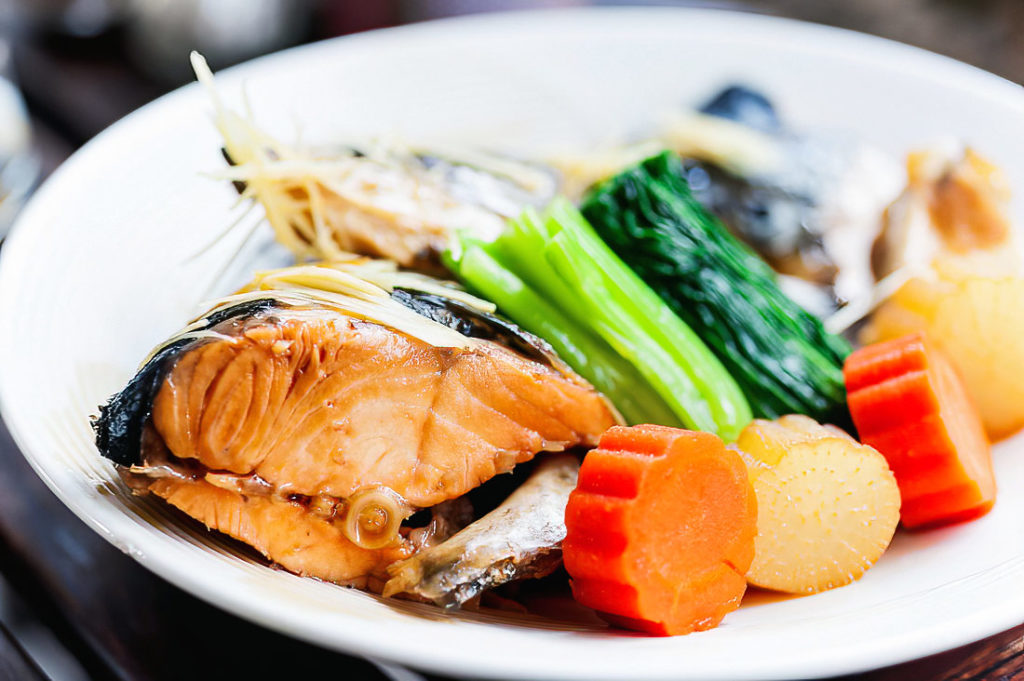This modern International twist on the traditional Japanese Salmon Kabutoni features rich, sweet soy sauce and fragrant ginger.
Preparation Time
- Prep Time: 15 minutes
- Cook Time: 25 minutes
- Total Time: 40 minutes
Ingredients (for four people)
- 4 salmon fillets (or one large salmon head, cleaned, if preferred)
- 1 medium daikon radish, peeled and cut into thick rounds
- 2 large carrots, sliced
- 8-10 fresh okra pods, ends trimmed
- 2-inch piece of ginger, peeled and julienned
- 1/2 cup (120 ml) soy sauce (preferably Japanese, shoyu)
- 1/4 cup (60 ml) mirin (sweet rice wine)
- 1/4 cup (60 ml) sake (optional, can substitute with water)
- 2 tbsp sugar
- 1 tbsp vegetable oil
- 1/2 cup (120 ml) water
1 tablespoon is circa 15 ml, and a teaspoon is circa 5 ml.
Preparation Method
Step 1: Prepare the Vegetables
- Peel and slice the daikon radish and carrots into thick rounds. Set aside.
- Trim the ends of the okra pods and set them aside as well.
Step 2: Make the Sweet Soy Sauce
- Combine the soy sauce, mirin, sake, sugar, and water in a medium saucepan.
- Heat the mixture over medium heat until the sugar dissolves, then bring it to a simmer. Stir in the julienned ginger and simmer for 5 minutes to infuse the flavor.
Step 3: Cook the Salmon and Vegetables
- Heat the vegetable oil over medium heat in a large skillet or pan.
- If you use salmon fillets, place them skin-side down in the pan. If you use salmon head, put it in the pan, flesh-side down.
- Add the daikon radish and carrot slices to the pan. Pour the sweet soy sauce mixture over the salmon and vegetables, ensuring they are all submerged.
- Bring the mixture to a gentle simmer and cover the pan with a lid. Let it cook for 10-15 minutes or until the salmon is cooked through and the vegetables are tender.
Step 4: Add the Okra
- Add the okra pods to the pan during the last 5 minutes of cooking and cover again. The okra should soften without overcooking.
Step 5: Serve
- Carefully remove the salmon fillets (or salmon head) and vegetables from the pan.
- Serve with a generous spoonful of the sauce over the salmon and vegetables. Garnish with additional julienned ginger if desired.

Tips and Tricks
- Salmon head: If you’re using the salmon head, ensure it’s thoroughly cleaned and cooked for even cooking. Check out our general principles on choosing fish on the market.
- Fillet variation: If you’re using fillets, cook them skin-side down first to crisp up the skin.
- Balance the sweetness: Adjust the amount of sugar to balance the sauce’s sweetness to your liking.
- Thicker sauce: If you prefer a thicker sauce, reduce it by simmering it uncovered for 5 minutes.
Serving Suggestions
- Pair this dish with steamed white or sushi rice for a truly authentic Japanese experience.
- A simple cucumber salad with sesame seeds and rice vinegar dressing is also perfect.
Wine Matching
This dish pairs well with a crisp, dry white wine. Try a Sauvignon Blanc or a Grüner Veltliner. For a Bulgarian option, a crisp Tamyanka or a Dimyat would complement the delicate flavors of the fish and soy sauce.
Storage Suggestions
- Refrigeration: Store any leftovers in an airtight container in the refrigerator for up to 2 days. Reheat gently in a pan over low heat to maintain the sauce’s integrity.
- Freezing: This dish is best enjoyed fresh, as freezing may change the texture of the salmon and vegetables.
Nutritional Information (per serving)
- Calories: 380 kcal
- Protein: 30 g
- Fat: 18 g
- Carbohydrates: 20 g
- Sodium: 860 mg
- Fiber: 4 g
Dietary Modifications
- Gluten-Free: Use tamari instead of soy sauce for a gluten-free version.
- Low-sodium: Opt for low-sodium soy sauce to control salt levels.
- Vegan Alternative: Substitute the salmon with firm tofu or king oyster mushrooms and use a vegetable-based broth instead of fish.
About Salmon Kabutoni
Salmon Kabutoni is a traditional Japanese dish made by simmering salmon heads in sweet soy sauce. It’s typically served with vegetables like radish and carrot, offering a harmonious blend of savory and slightly sweet flavors. While the traditional recipe can be intimidating with salmon heads, fillets make it more accessible and family-friendly. Salmon Kabutoni is elegant and comforting, making it a staple in Japanese households.
Cultural Context
Salmon head (Kabuto) is often used in soups and stews in Japan, and its rich flavor is highly valued. This recipe adapts the tradition, making it more approachable by using fillets yet still paying homage to its origins. The dish is a favorite in many Japanese families and is mainly known for being easy to prepare, delicious, and full of nutritious elements.


